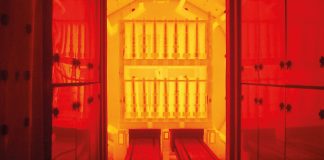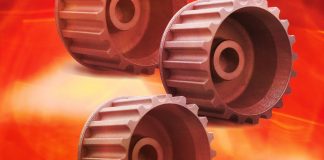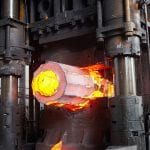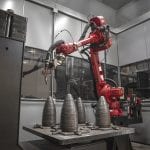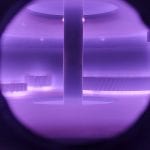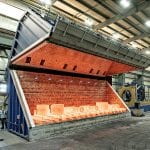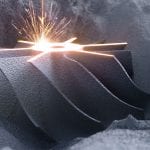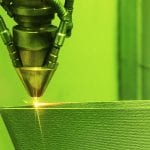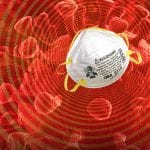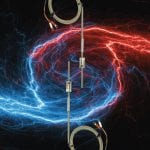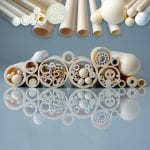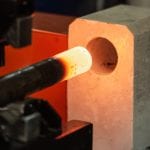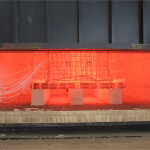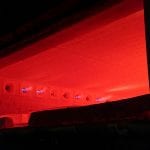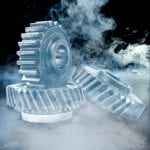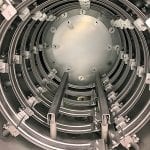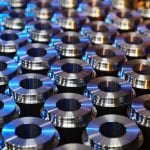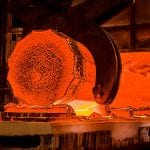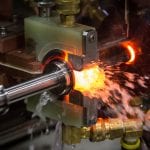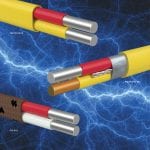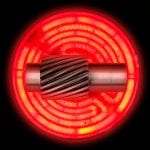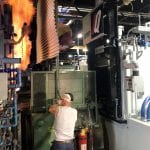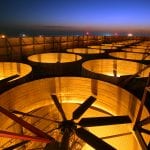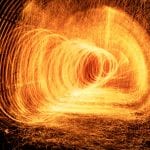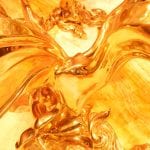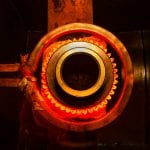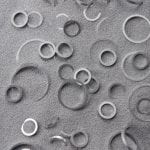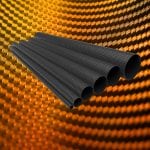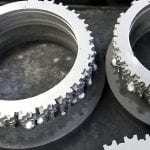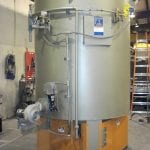Bringing forging equipment online to meet expanding production requirements
When forging operations need to expand production to meet increased demand for existing parts or to add new product lines, selecting from the available...
Advantages of wire-arc additive manufacturing
The concept of additive manufacturing has been around for a century, but with the advent of sophisticated software and robotics, the process is fast...
Does nitriding improve the corrosion and wear properties of additive manufactured stainless steel?
Many industrial processes require a stable heat source to generate end-products. Heat transfer fluids (HTFs) are commonly used in such processes as heat carriers...
A study of temperature effect on properties of nitride layers on X37CrMoV51 tool steel...
The paper concerns the effect of annealing time and temperature on the properties of the nitride layer on X37CrMoV51 tool steel used in the...
The cutting edge of thermal processing in a forge environment
Scot Forge is a 128-year-old, 100-percent employee-owned forging company that works in multiple markets from large defense, aerospace, power generation and mining projects to...
A review of lubricant removal systems and the latest technology
Whether a component is produced through binder-jet additive manufacturing, metal injection molding, or conventional press and sintering, lubricant removal continues to be one of...
Case study: Determining the cause of cracking using computer modeling
During an induction-hardening process, the part surface is heated using a medium- to high-frequency inductor. Once the desired depth of austenitization is reached, the...
4D high-pressure gas quenching
Thermal processing and quenching of steels for hardening is a well-established practice performed by various techniques over the centuries. A common thread has been...
Heat Treatments and Critical Quenching Rates in Additively Manufactured Al–Si–Mg Alloys
Laser powder-bed fusion (LPBF) has significantly gained in importance and has become one of the major fabrication techniques within metal additive manufacturing. The fast...
Commercial sintering of chromium powder metallurgy (PM) steels
Chromium was introduced as a potential alloying element for powder metallurgy (PM) steels in the 1990s. Since then, numerous chromium-containing alloy systems have been...
Laser sintering of thermoset polyimide composites
Selective laser sintering (SLS) is an additive manufacturing technique that builds 3D models layer-by-layer using a laser to selectively melt cross sections in powdered...
Going viral: Outside-the-box research into sterilizing N95 masks for re-use
With the COVID-19 pandemic still raging across the country and the world, the need for personal protective equipment for medical professionals has pushed the...
Temperature sensor selection: The basics of temperature measurement using thermocouples
You are probably somewhat familiar with the thermocouple, or you wouldn’t be reading this article. But there are important points about thermocouples that must...
Heat work to the fore
Sporting its new tagline — Enabling a Clean, Efficient & Electrified Future — the highly regarded Ceramics Expo will once again head for Cleveland’s...
Spectroscopic study of plasma nitrocarburizing processes with an industrial-scale carbon active screen
The active screen plasma nitrocarburizing technology is an improvement of conventional plasma nitrocarburizing by providing a homogeneous temperature distribution within the workload and reducing...
Pyrometry – A Different Take
Any article on pyrometry, as it applies to AMS2750 and thermal processing, usually gets a lot of attention. Typically filled with interpretation, clarification, and...
Process control, monitoring, and quality assurance specifics for induction heating
Controlling the induction-hardening process is a demanding application compared to most other thermal processes. The first and foremost requirement is to precisely control the...
Temperature uniformity survey ( TUS ) general practice for CQI-9 and AMS2750E
In the automotive and aerospace manufacturing industry, CQI-9 and AMS2750 specifications are established as guidelines to:
“address pyrometric requirements for thermal processing equipment used for...
The Future of Kiln Lining
Lining iron and steel furnaces is critical to extend the life of the furnaces and to protect the purity of the metals being heat...
Embracing industry change
Most companies, regardless of the industry or business, want to see improvement. Whether it is improving customer satisfaction or quality or bottom-line profit or...
Take Another Look at Deep Cryogenic Treatment
What is happening in the world of Deep Cryogenic Treatment (DCT)? Research into this field is exploding. Research is coming from companies and major...
Vacuum heat treatment for additive manufacturing
Additive manufacturing means any technology capable of obtaining a final component starting from a 3D CAD file and adding material layer by layer. At...
Combining cleanness, strength, and toughness for affordable power densification in steel components
Increased power density in mechanical power transmission components means greater durability — allowing existing designs to achieve greater capacity or reduced size and mass...
Nonlinear electromagnetic acoustic testing method for tensile damage evaluation
This paper describes an approach for measuring material plasticity using contactless electromagnetic acoustic method. Harmonic generation from noncumulative fundamental longitudinal wave in specimen is...
Operational efficiencies and minimizing energy consumption: An introduction
Energy conservation is the prevention of the wasteful use of energy. In today’s economic and climate-change environment, regulations and competition for resources require industrial...
Troubleshooting and Prevention of Cracking in Induction Hardening of Steels: Lessons Learned –...
One of the most common applications of induction heat treatment is the hardening of steels, cast irons, and powder-metallurgy materials, developing an attractive blend...
Optimizing Temperature Measurement in Heat-Treatment Operations
Quality and efficiency in heat-treatment operations requires accurate temperature measurement. Specifying thermocouple wire and thermocouples carefully will lead to greater temperature measurement accuracy and...
Troubleshooting and Prevention of Cracking in Induction Hardening of Steels: Lessons Learned – Part 1
Newly employed heat-treat engineers, designers and practitioners may need an appreciable amount of time to gain the required knowledge and experience in understanding the...
Intelligent Gas Carburizing with Super IQ ™
Atmosphere furnace or vacuum furnace, which to use? In carburizing, for instance, the workhorse furnace is the atmosphere gas carburizing furnace with integral oil...
New Cooling Tower Technology Augments HVAC and Industrial Processes
Recent developments in factory-assembled cooling-tower technology are increasing the applications for so-called “package” towers supporting HVAC and industrial processes. Although field-erected towers have been...
Improving audit performance
To add value to the aerospace suppliers who participate in Nadcap, there is an ongoing effort to do more to assist them in successfully...
Selection of Oil Quenchants for Heat-Treating Processes
Modern quenching oils offer a wide range of capability and performance. The selection of the proper quench oil is critical for proper heat-treating operations....
An In-Depth Look at Polymer Quenchants
Quenching of various alloys to achieve mechanical properties has been an area of scientific research for many years. Using polymer quenchants has proven to...
Recent progress in three areas of induction-heating technology
This paper introduces recent research progress of induction heating technology at Baosteel, specifically the development of full coil static induction heating technology of the...
Energy and material efficiency of steel powder metallurgy
Concern about global warming motivates the reduction of greenhouse gas emissions from manufacturing, but the environmental impact of the whole powder metallurgy production chain...
Sintering experiments under way on International Space Station
Gravity is a nonuniform stress that influences sintering densification, microstructure evolution, final properties, and dimensional uniformity. An early conjecture was that in the absence...
Filament-Wound Composites Have Specialized Curing Requirements
Filament winding is a manufacturing method for making tubular and cylindrical shapes of extreme strength and light weight. The technology involves wrapping a mandrel...
Machining graphite components
The various forms and fixtures used in vacuum furnaces and various sintering operations nearly all require graphite. Machining some of these graphite components can...
Principles of pyrometry
Regarding comprehension, on a scale of 1 to 10, AMS2750E is about a 12. Practically speaking, when an engineer, quality person, or operator picks...
The versatility of the pit furnace
Top-loading furnaces, commonly referred to as pit furnaces, have played a major role in the heating treating landscape for the last century or longer....












